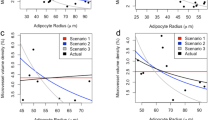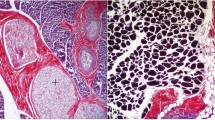Abstract
Recent studies have shown that harbor seals (Phoca vitulina) have an increased skeletal muscle mitochondrial volume density that may be an adaptation for maintaining aerobic metabolism during diving. However, these studies were based on single samples taken from locomotory muscles. In this study, we took multiple samples from a transverse section of the epaxial (primary locomotory) muscles and single samples from the m. pectoralis (secondary locomotory) muscle of five wild harbor seals. Average mitochondrial volume density of the epaxial muscles was 5.6%, which was 36.6% higher than predicted for a terrestrial mammal of similar mass, and most (82.1%) of the mitochondria were interfibrillar, unlike athletic terrestrial mammals. In the epaxial muscles, the total mitochondrial volume density was significantly greater in samples collected from the deep (6.0%) compared with superficial (5.0%) regions. Volume density of mitochondria in the pectoralis muscle was similar (5.2%) to that of the epaxial muscles. Taken together, these adaptations reduce the intracellular distance between mitochondria and oxymyoglobin and increase the mitochondrial diffusion surface area. This, in combination with elevated myoglobin concentrations, potentially increases the rate of oxygen diffusion into mitochondria and prevents diffusion limitation so that aerobic metabolism can be maintained under low oxygen partial pressure that develops during diving.





Similar content being viewed by others
References
Armstrong RB (1981) Recruitment of muscles and fibres within muscles in running animals. Symp Zool Soc Lond 48:289–304
Armstrong RB, Laughlin MH (1985) Metabolic indicators of fibre recruitment in mammalian muscles during locomotion. J Exp Biol 115:201–213
Armstrong RB, Phelps RO (1984) Muscle fiber type composition of the rat hind limb. Am J Anat 171:259–272
Armstrong RB, Saubert CW IV, Seeherman HJ, Taylor CR (1982) Fiber type distribution in locomotory muscles of dogs. Am J Anat 163:87–98
Bicudo JEPW, Longworth KE, Jones JH, Taylor CR, Hoppeler H (1996) Structural determinants of maximal O2 transport in muscles of exercising foxes. Resp Physiol 103:243–251
Blessing MH, Hartschen-Niemeyer E (1969) Uber den Myoglobin-gehalt der Herz und Skelettmuskulatur inbesonderes einiger mariner Sauger. Z Biol 116:302–313
Buser KS, Kopp B, Gehr P, Weibel ER, Hoppeler H (1982) Effect of cold environment on skeletal muscle mitochondria in growing rats. Cell Tiss Tes 225:427–436
Cherepanova V, Neshumova T, Elsner R (1993) Muscle blood flow in diving mammals. Comp Biochem Physiol 106A:1–6
Davis RW, Kanatous SB (1999) Convective oxygen transport and tissue oxygen consumption in Weddell Seals during aerobic dives. J Exp Biol 202:1091–1113
Davis RW, Polasek L, Watson R, Fuson A, Williams TM, Kanatous SB (2004) The diving paradox: new insights into the role of the dive response in air-breathing vertebrates. Comp Biochem Physiol Part A 138:263–268
Delp MD, Duan C (1996) Composition and size of type I, IIA, IID/X, and IIB fibers and citrate synthase activity of rat muscle. J Appl Physiol 80:261–270
Desplanches D, Favier R, Sempore B, Hoppeler H (1991) Whole body and muscle respiratory capacity with dobutamine and hindlimb suspension. J Appl Physiol 71:2419–2424
Fish FE, Innes S, Ronald K (1988) Kinematics and estimated thrust production of swimming harp and ringed seals. J Exp Biol 137:157–173
Goslow GE Jr, Seeherman HJ, Taylor CR, McCutchin MN, Heglund NC (1981) Electrical activity and relative length changes of dog limb muscles as a function of speed and gait. J Exp Biol 94:15–42
Hochachka PW, Foreman RA III (1993) Phocid and cetacean blueprints of muscle metabolism. Can J Zool 71:2089–2098
Hoppeler H (1986) Exercise-induced ultrastructural changes in skeletal muscle. Int J Sports Med 7:187–204
Hoppeler H, Mathieu O, Krauer R, Classen H, Armstrong RB, Weibel ER (1981) Design of the mammalian respiratory system. VI. Distribution of mitochondria and capillaries in various muscles. Resp Physiol 44:87–111
Hoppeler H, Kayar SR, Claassen H, Uhlmann E, Karas RH (1987) Adaptive variation in the mammalian respiratory system in relation to energetic demand: III. Skeletal muscles: setting the demand for oxygen. Resp Physiol 69:27–46
Howell AB (1928) Contribution to the comparative anatomy of the eared and earless seals (genera Zalophus and Phoca). Proc US Natl Mus 73:1–142
Irving L (1939) On the ability of warm-blooded animals to survive without breathing. Sci Mon 38:422–428
Kanatous SB, DiMichele LV, Cowan DF, Davis RW (1999) High aerobic capacities in the skeletal muscles of pinnipeds: adaptations to diving hypoxia. J Appl Physiol 86:1247–1256
Kanatous SB, Elsner R, Mathieu-Costello O (2001) Muscle capillary supply in harbor seals. J Appl Physiol 90:1919–1926
Kanatous SB, Davis RW, Watson RR, Polasek L, Williams TM, Mathieu-Costello O (2002) Aerobic capacities in the skeletal muscles of Weddell seals: key to longer dive durations? J Exp Biol 205:3601–3608
Karlstrom K, Essen-Gustavsson B, Lindholm A (1994) Fibre type distribution, capillarization and enzymatic profile of locomotor and nonlocomotor muscles of horses and steer. Acta Anat (Basel) 151:97–106
Kayar SR, Claassen H, Hoppeler H, Weibel ER (1986) Mitochondrial distribution in relation to changes in muscle metabolism in rat soleus. Resp Physiol 64:1–11
Kayar SR, Hoppeler H, Lindstedt SL, Claassen H, Jones JH, Essen-Gustavsson B, Taylor CR (1989) Total mitochondrial volume in relation to aerobic capacity of horses and steers. Pflügers Archiv 413:343–347
Kayar SR, Hoppeler H, Armstrong RB, Laughlin MH, Lindstedt SL, Jones JH, Conley KE, Taylor CR (1992) Estimating transit time for capillary blood in selected muscles of exercising mammals. Pflügers Archiv 421:578–584
Kerem D, Hammond DD, Elsner R (1973) Tissue glycogen levels in the Weddell seal, Leptonychotes weddelli: a possible adaptation to asphyxial hypoxia. Comp Biochem Physiol A 45:731–736
Kline KH, Bechtel PJ (1988) Changes in the metabolic profile of the equine gluteus medius as a function of sampling depth. Comp Biochem Physiol 91A:815–819
Lenfant C, Johansen K, Torrance JD (1970) Gas transport and oxygen storage capacity in some pinnipeds and the sea otter. Resp Physiol 9:277–286
Mathieu O, Cruz-Orive LM, Hoppeler H, Weibel ER (1981a) Measuring error and sampling variation in stereology: comparison of the efficiency of various methods for planar image analysis. J Microsc 121:75–88
Mathieu O, Krauer R, Hoppeler H, Gehr P, Lindstedt SL, McNeill Alexander R, Taylor CR, Weibel ER (1981b) Design of the mammalian respiratory system. VII. Scaling mitochondrial volume in skeletal muscle to body mass. Resp Physiol 44:113–128
Mathieu-Costello O, Suarez RK, Hochachka PW (1992) Capillary-to-fiber geometry and mitochondrial density in hummingbird flight muscle. Respir Physiol 89:113–132
Mathieu-Costello O, Ju Y, Trejo-Moralis M, Cui L (2005) Greater capillary-fiber interface per fiber mitochondrial volume in skeletal muscles of old rats. J Appl Physiol 99:281–289
Mattson JP, Miller TA, Poole DC, Delp MD (2002) Fiber composition and oxidative capacity of hamster skeletal muscle. J Histochem Cytochem 50:1685–1692
Pette D, Staron RS (1990) Cellular and molecular diversities of mammalian skeletal muscle fibers. Rev Physiol Biochem Pharmacol 116:1–76
Pitcher KW, Calkins D (1979) Biology of the harbor seal, Phoca vitulina richardsi, in the Gulf of Alaska (Technical Report). Anchorage, AK, U.S. Dep. Commerce, NOAA, OCSEAP 19:231–310
Polasek LK, Dickson KA, Davis RW (2006) Metabolic indicators in the skeletal muscles of harbor seals (Phoca vitulina). Am J Physiol Regul Integr Comp Physiol. 290:R1720–R1727
Poole DC, Mathieu-Costello O (1996) Relationship between fiber capillarization and mitochondrial volume density in control and trained rat soleus and plantaris muscles. Microcirculation 3:175–186
Reed JZ, Butler PJ, Fedak MA (1994) The metabolic characteristics of the locomotory muscles of grey seals (Halichoerus grypus), harbour seals (Phoca vitulina), and Antarctic fur seals (Arctocephalus gazella). J Exp Biol 194:33–46
Rivero J-LL, Serrano AL, Diz AM, Morales JL (1993) Changes in cross-sectional area and capillary supply of the muscle fiber population in equine gluteus medius muscle as a function of sampling depth. Am J Vet Res 54:32–37
Robinson D (1939) The muscle hemoglobin of seals as an oxygen store in diving. Science 90:276–277
Sillau AH, Aquin L, Bui MV, Banchero N (1980) Chronic hypoxia does not affect guinea pig skeletal muscle capillarity. Pflugers Arch 386:39–45
Suarez RK, Lighton JRB, Brown GS, Mathieu-Costello O (1991) Mitochondrial respiration in hummingbird flight muscles. Proc Natl Acad Sci USA 88:4870–4873
Van Ekeren GJ, Sengers RCA, Stadhouders AM (1992) Changes in volume densities and distribution of mitochondria in rat skeletal muscle after chronic hypoxia. Int J Exp Path 73:51–60
Watson RR, Miller TA, Davis RW (2003) Immunohistochemical fiber typing of harbor seal locomotory muscle. J Exp Biol 206:4105–4111
Weibel ER (1979) Stereological Methods. vol 1. Practical methods for biological morphometry. Academic, New York, p 415
Wittenberg JB, Wittenberg BA (2003) Review: myoglobin function reassessed. J Exp Biol 206:2011–2022
Acknowledgments
We thank the Alaska Native Harbor Seal Commission and F. Weltz for assistance in obtaining tissue samples. We also thank V. Popov of the Department of Pathology at the University of Texas Medical Branch, Galveston for TEM expertise and advice. H. Smith and B. Rowlingson provided assistance with statistical analyses. We thank O. Mathieu-Costello and three anonymous reviewers for helpful comments on the manuscript. The research described in this paper was supported by the Exxon Valdez Oil Spill Trustee Council. However, the findings and conclusions presented by the authors are their own and do not necessarily reflect the views or position of the Trustee Council.
Author information
Authors and Affiliations
Corresponding author
Additional information
Communicated by H.V. Carey
Rights and permissions
About this article
Cite this article
Watson, R.R., Kanatous, S.B., Cowan, D.F. et al. Volume density and distribution of mitochondria in harbor seal (Phoca vitulina) skeletal muscle. J Comp Physiol B 177, 89–98 (2007). https://doi.org/10.1007/s00360-006-0111-x
Received:
Revised:
Accepted:
Published:
Issue Date:
DOI: https://doi.org/10.1007/s00360-006-0111-x




